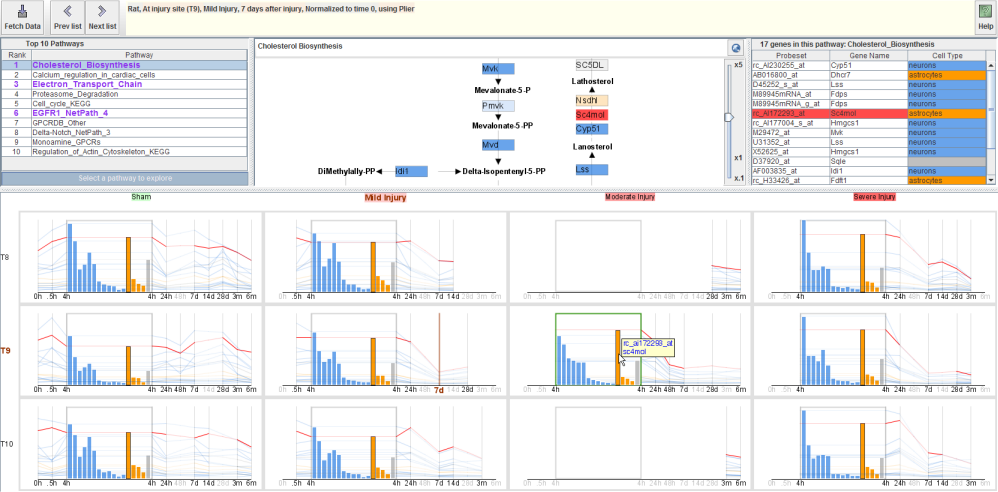
A widespread use of high-throughput gene expression analysis techniques enabled the biomedical research community to share a huge body of gene expression datasets in many public databases on the web. However, current gene expression data repositories provide static representations of the data and support limited interactions. This hinders biologists from effectively exploring shared gene expression datasets. Responding to the growing need for better interfaces to improve the utility of the public datasets, we have designed and developed a new web-based visual interface entitled "GeneShelf". It builds upon a zoomable grid display to represent two categorical dimensions. It also incorporates an augmented timeline with expandable time points that better shows multiple data values for the focused time point by embedding bar charts. We applied GeneShelf to one of the largest microarray datasets generated to study the progression and recovery process of injuries at the spinal cord of mice and rats - Traumatic spinal cord injury.
Traumatic spinal cord injury (SCI) is characterized by a primary mechanical insult, followed by widespread, coordinated changes in gene expression. These may be associated with pathogenic auto-destructive events such as hemorrhage, metabolic failure, inflammatory/immune activation, loss of ionic homeostasis, lipid degradation, production of free radicals, and neurotransmitter and growth factor imbalances. These changes may contribute to neuronal and oligodendroglial cell death, astrocyte proliferation (scarring) and demyelination. Alternatively, reactive expression changes that are neuroprotective and/or promote recovery (regeneration/plasticity) may also be induced. In addition, not all mechanisms following SCI are well known.
The NINDS recently supported the creation of a large database of quality-controlled Affymetrix profiles of spinal cord tissue taken from 1 hour to 6 months after mild, moderate or severe thoracic SCI (T9) in the rat. Spinal cord samples were also profiled from 30 minutes to 28 days after moderate thoracic injury (T9) in the mouse. Sampled regions included areas above (rostral), at (epicenter) and below (caudal) the site of impact. The goal of this project is provide a large scale analysis of expression events after SCI.
We released the first visual interface called "SpinalCordLink" last year. Incorporating users' comments and addressing usability problems, we designed and developed a new visual interface called "GeneShelf". GeneShelf also integrates biological pathways from WikiPathways.org. We used a new data processing framework to integrate relevant pathway information into the analysis process.
This work was supported by NIH NINDS-01 (NS-1-2339) and by NIH NCMRR/NINDS 5R24 HD 050846 (Integrated Molecular Core for Rehabilitation Medicine).
GeneShelf is a Java application built on Piccolo toolkit.
NOTE: If you do not have Java installed on your computer, you have to install Java (Java SE Runtime Environment 6 or higher) first to launch GeneShelf. If you are prompted to install a new Java after clicking on one of the links above, you have to install it first. To properly run GeneShelf, Sun's Java Virtual machine is necessary. You can down load it from the Java SE Downloads page